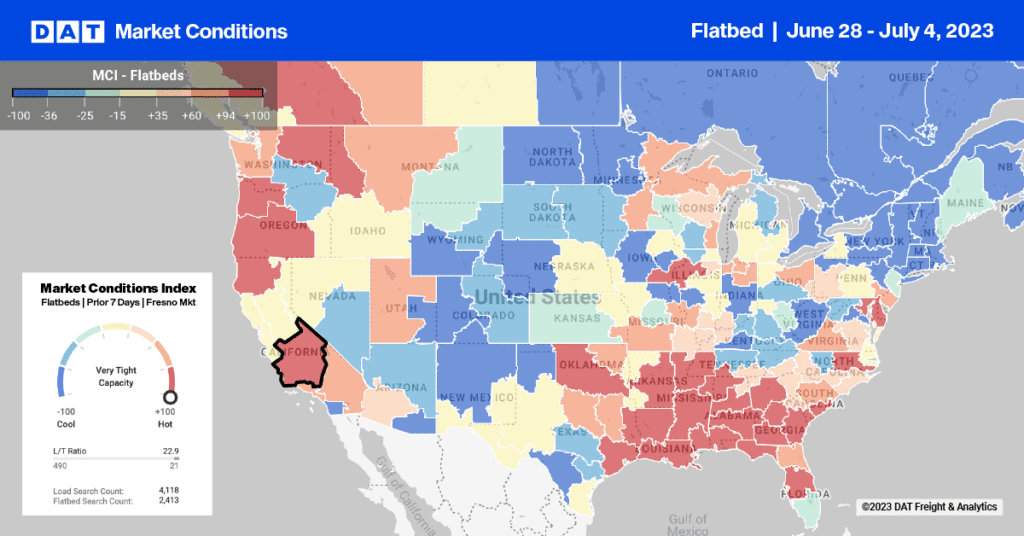As I write this, there is only one lane in the U.S. that pays a dollar a mile — vans from Philadelphia to Chicago were getting $0.48 for line haul plus a fuel surcharge of $0.52 during the week ending March 17.
Carriers used to cover costs on a “buck-a-mile” backhaul, but it seems pretty clear that the carrier’s break-even point is well above a dollar a mile today. Your actual costs may vary, but I just want to make a couple of points so please bear with me.
| THEN | PRO-RATED COSTS | NOW |
| $0.25 | Fuel | $0.71 |
| $0.25 | Equipment and overhead | $0.34 |
| $0.25 | Maintenance and tires | $0.33 |
| $0.25 | Driver pay | $0.37 |
| $1.00 | Total cost to operate truck | $1.75 |
Here’s a little more detail. You’re welcome to fire up your spreadsheet software and supply your own numbers:
Fuel costs averaged $4.14 per gallon in the U.S. last week, but if you filled up on the East or West Coast, you paid about $4.25. Let’s say you’re getting six miles to the gallon. Divide $4.25 by 6, and you get 71 cents per mile for fuel.
Equipment leases could be the biggest bargain, compared to the olden days. Let’s say you have a monthly payment on a five-year equipment lease for $130,000, at 8% interest. That payment would cost you about $2,600 per month. If your truck is making 450 miles a day, 20 days per month, that’s 9,000 miles. So your lease payment costs you about 28.6 cents per mile. Add insurance, title and licensing, sprinkle in a little overhead and we’ll call it 34 cents. These are fixed costs, so you’ll have to pay them even if your truck is parked temporarily.
Maintenance and tire costs vary depending on make and age of equipment. I’m going to add another 33 cents to cover this expense, but yours may be different.
Driver pay may be as low as 37 cents per mile now, but everyone keeps saying how hard it is to find qualified drivers and turnover is getting bad, so if you want to retain your best people you’re going to pay them a little more. Driver pay will increase this year.
It adds up pretty fast. Let’s say costs total $1.75 per mile, or somewhere in that ballpark. A small fleet or owner-operator should target at least 10% above costs, to produce an operating profit: that’s $1.75 plus 17.5 cents, which gets you to $1.93. Wow. That’s a long way from “a buck a mile.”
There are plenty of back hauls that just do not pay $1.93 per mile, or $1.75, even including the fuel surcharge. But you could still be okay, if your head haul rate covers the difference.
Maybe your back haul pays reasonably well in the spring and summer months, but it’s not much more than the proverbial buck-a-mile in the winter. Your year-round average is $1.43. That means you have to make up the missing 50 cents on your head haul, so you can average $1.93 for the round trip. Now you need to persuade your shipper customer to pay you at least $2.43 a mile for the head haul.
Before you enter into contract negotiations with your shipper customers, you’ll need a few critical pieces of information:
Know your costs. Use the outline above, make a spreadsheet, and remember to include your fixed costs (leases, insurance, licenses, and overhead, including any facilities and administrative salaries.)
Know the rates in your lanes. If you accept the contract, what can you realistically expect to get paid on the back haul? Does the rate vary by season? How much deadhead is involved?
Using DAT Truckload Rate Index, you can find a combined pair of lanes that will provide the result you need. If your head haul doesn’t match up well, consider a “trihaul.” That’s when you a higher-paying third leg to your trip, to boost your average revenue per mile.
DAT load boards can also help with your equipment utilization. Most carriers think that carrying 100% contract freight will be their ticket to profitability, but in fact, they end up with a lot of empty miles. Carriers who use the DAT load boards to find between 30% and 60% of their loads made $1,370 more per truck per month than their peers. They kept empty miles below 10% and they drove more miles overall, for a higher number of loaded miles. Those were the results of a survey conducted in 2011, and the previous year’s carrier survey led to the same conclusion.


